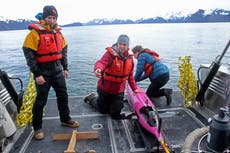Prehistoric DNA finds evidence of ancient ‘pizzly bear’ hybrids
Polar bear and brown bear hybrids have been spotted in recent years too, possibly spurred by warmer temperatures bringing the two species together
The tooth of a very old polar bear has revealed new insight into the mixed history of polar bears and brown bears.
Researchers used DNA from a tooth embedded in a 130,000-year-old polar bear jaw to map the genetic history of the two species, finding new details on interbreeding may have shaped their evolution.
In the past couple decades, warmer temperatures spurred by the climate crisis have brought the two species in contact more often — sometimes resulting in hybrid “pizzly bears”. And understanding how wildlife have responded to changes in the past could help us understand how they’ll respond to change in the future, Charlotte Lindqvist, an evolutionary biologist at the University of Buffalo tells The Independent.
“As we’re going into a time with lots of changes, global climate change — what really is going to happen to the species we know today?” she asks.
The team analysed DNA from modern polar bears and brown bears (also known as grizzly bears), as well as DNA from the prehistoric polar bear jaw, from an animal that lived on the Norwegian archipelago of Svalbard between 115,000 and 130,000 years ago.
With that information, they could look at the genetic relationships between the two species over time to get a sense of their evolutionary history. The results were published on Monday in Proceedings of the National Academy of Science.
Their findings show that the two bears split into distinct species around 1.5 million years ago, with the polar bears occupying the colder, icier Arctic and brown bears living in lower, warmer latitudes.
But interbreeding didn’t stop after that split, the study notes, as both polar bears and brown bears show evidence of genes inherited from the other species.
Previous studies suggested that genes really only went from polar bears into brown bears, Dr Lindqvist says, not the other way around — but their study suggests that the genes would more often flow in the other direction, from brown bears into polar bears.
That could be relevant to today’s intermixing polar and brown bears, she adds.
If the two species interbreed more often, you could get more of the “generalist” genes from brown bears entering into the more “specialist” polar bear lineage, Dr Lindqvist says — which could theoretically help the more specialised polar bears adapt to changing conditions.
But that’s just a theory, and the climate crisis is probably changing global temperatures too quickly for any kind of hybridisation to make an impact on survival, Dr Lindqvist adds. And she’s quick to note that polar bears also probably face more overwhelming pressures from the climate crisis, like habitat loss.
These kinds of studies can help scientists understand how these species may respond to changing conditions however, and what the recent rise of “pizzly bears” might mean for the animals.
“We’re reading history books to try and understand our present as well,” Dr Lindqvist says. “This is the same idea, it’s just going sometimes much further back in time.”
Join our commenting forum
Join thought-provoking conversations, follow other Independent readers and see their replies
Comments


Bookmark popover
Removed from bookmarks